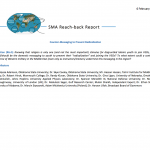Counter-Messaging to Prevent Radicalization
Question (R6.4): Knowing that religion is only one (and not the most important) stimulus for disgruntled Islamic youth to join VEOs, what could/should be the domestic messaging to youth to prevent their “radicalization” and joining the VEOs? To what extent could a continued presence of Western military in the Middle East (even only as instructors/trainers) undermine this messaging in the region?
Author | Editor: Canna, S. (NSI, Inc).
Executive Summary
After the fall of Mosul, as it became clear that Daesh could no longer creditably claim broad swaths of territory for its caliphate, it deliberately reverted to a strategy of insurgency, according to Syrian expert Hassan Hassan.1 Its withdrawal into the rural desert landscape—and to what a radicalization expert, Haroon Ulla, calls the “cloud caliphate”2—has implications for counter-radicalization messaging. Hassan reminds us that when the organization was defeated in the late 2000s, it came back stronger than ever. He notes that its messaging has recently pivoted to attempts to erode trust between Sunni Arab populations and any form of legitimate government. Daesh’s messaging is fueled by the recent memory of the failure of the Sahwa (or Awakening) movement to produce meaningful political reforms for Sunni populations in Iraq. In Syria, Daesh still benefits from the ongoing conflict and enduring Sunni Muslim grievances. At the same time, hardened foreign fighters are leaving Syria and Iraq for other regions where extremism is flourishing including the Sinai region of Egypt and Yemen (Hassan). And, of course, some foreign fighters are returning home across the globe where they can be incubators of future generations of extremists (Hassan).
So given Daesh’s return to insurgency and its embrace of information age recruitment techniques, what are the grievances3 driving the radicalization of youth in Iraq and Syria, and what messages would be effective in tarnishing the appeal of extremism? It bears repeating that effective counter extremism messaging in Iraq and Syria requires state and local governments to match promises of reform with actual reform (Kluver, Sager). Dr. Sager reminds readers that between 2007 and 2009, Daesh disappeared from Iraq as the result of the Sahwa movement. But once promised political reform failed to actualize, Daesh came back. This failure of reform cemented the conclusion that the only way to enact reform is through violence. As Hassan notes, Daesh has already begun sowing doubt along these lines.
What is concerning to Dr. Ian McCulloh, a social science researcher and proponent of field research/population surveys, is that the USG has yet to realize that the remaining population of military aged males in Iraq—those most vulnerable to a new round of recruitment from Daesh, Al Qaeda, or other groups—has been stripped of its hard-core ideologues. Those who have not been killed, captured, or fled are likely to be poor, illiterate, and have limited access to social media. These factors may indicate that social media campaigns will have limited effect on this kind of population.
So if the most effective counter radicalization tool is visible political reform, the primary role for the US in counter extremism messaging is a supporting one encouraging regional governments to make meaningful reforms that address the driving forces7 of radicalization among marginalized Sunni groups (Kluver, Sager). When the USG engages in messaging, it should focus on 1) legitimizing government partners, 2) promoting economic development and regional stability, 3) supporting foreign aid, and 4) reinforcing cultural norms (Sager). For a discussion on how to undermine Daesh’s leadership, please see Dr. Gina Ligon’s article Leveraging Organizational Fissures to Degrade ISIL Top Management Team in the contribution section.
While a foreign military presence may be deemed necessary for a short time, contributors believe US military presence generally fuels radicalization narratives (Styszynski). Dr. Sager emphasized that in order to avoid undermining counter-radicalization messages with the presence of Western forces, the US should be seen as a catalyst for genuine political reform that benefits populations most at risk of radicalization: Sunni Arabs. The USG should exercise caution, however, to not take adopt general guidelines without further critical analysis, according to Dr. Allison Astorino-Courtois of NSI. If, for example, hardliners win Parliamentary elections in Iraq, visible US support for an administration that is viewed by many Sunni Arab Iraqi as opposed to their interests could fuel further political marginalization, alienation, and radicalization.
Contributors
Ms. Alyssa Adamson, Oklahoma State University; Dr. Skye Cooley, Oklahoma State University; Mr. Hassan Hassan, Tahrir Institute for Middle East Policy; Dr. Robert Hinck, Monmouth College; Dr. Randy Kluver, Oklahoma State University; Dr. Gina Ligon, University of Nebraska, Omaha; Dr. Ian McCulloh, Johns Hopkins University Applied Physics Laboratory; Dr. Spencer Meredith III, National Defense University; Dr. Nicholas O’Shaughnessy, University of London (UK); Dr. Abdulaziz Sager, Gulf Research Center; Mubin Shaikh, Independent Expert; Dr. Ethan Stokes, University of Alabama; Dr. Marcin Styszynski, Adam Mickiewicz University (Poland); Dr. Haroon Ullah, Broadcast Board of Governors

Comments